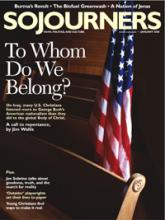In August 2007, in response to a massive government-mandated rise in oil and gas prices, public protests began in scattered towns around Burma. Buddhist monks took the lead in the growing number of marches for justice and freedom that, by Sept. 24, had risen to 100,000 people in the city of Yangon alone.
In mid-September, I was in Yangon facilitating a workshop about Gandhian nonviolence. After our daily discernment, one of my Burmese friends—I’ll call him Mahn—suggested that we go to the Shwedagon Pagoda. Dazzling gold, one hundred meters high, and visible for miles, Shwedagon is not only the most sacred shrine in Burma but also, for many, a symbol of Buddhist resistance to oppression. It was here on Aug. 28, 1988, in the midst of an earlier nonviolent uprising against the government’s brutal policies, that Aung San Suu Kyi addressed a crowd estimated at between 300,000 and 1 million people. The monks’ protest marches in September started with prayers at Shwedagon.
For several hours Mahn and I wandered, barefooted, over the massive grounds amid thousands of pilgrims and tourists. Often Mahn would go into a shrine, bow, kneel, and pray. Although the government-controlled press wasn’t reporting it, we knew from the grapevine that demonstrations were spreading around the country amid mounting anger at the plummeting economic situation.
Slowly the people were overcoming their fear—usually a trump card of bullies and oppressors—and publicly joining the struggle. There was nonetheless caution. At the outset of my visit I was told not to say the name Aung San Suu Kyi but only, in a soft voice, refer to “the Lady.”
Read the Full Article
